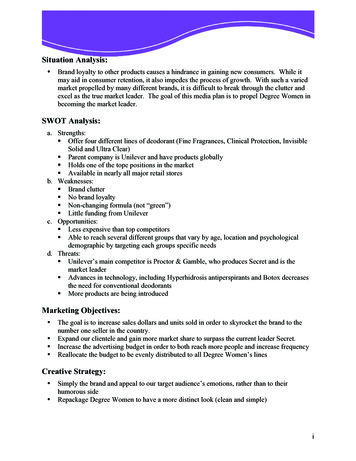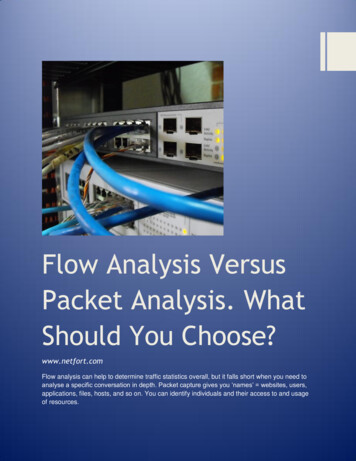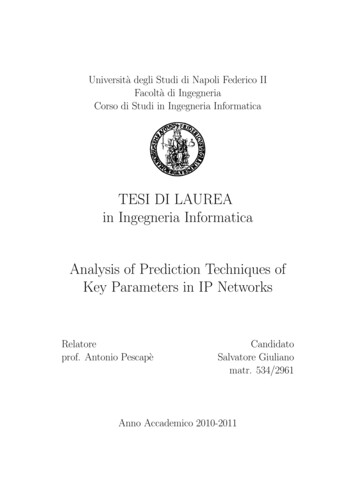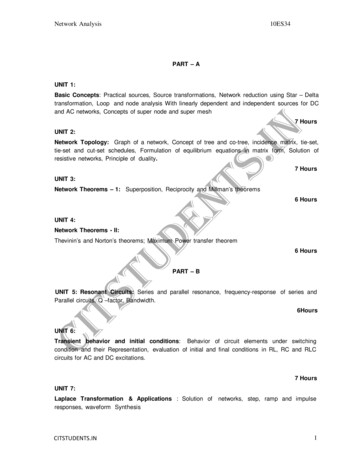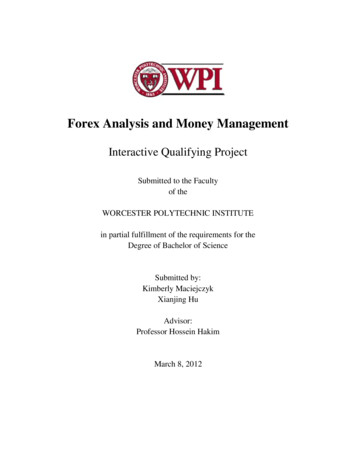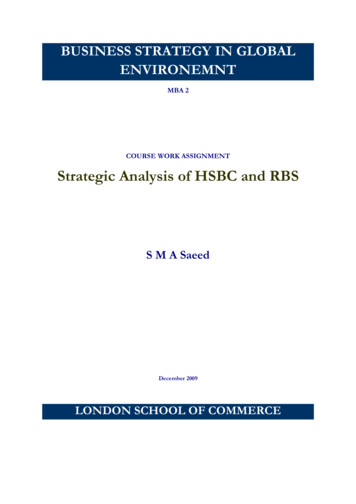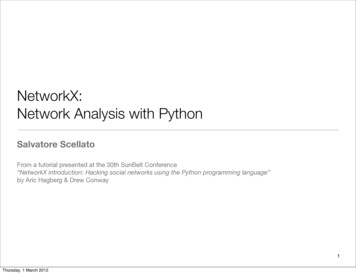![03[1] Analysis Of The Internal Environment](/img/2/031-analysis-of-the-internal-environment.jpg)
Transcription
CHAPTER 3Analysis of the gicManagementManagementof StrategyPowerPoint Presentation by Charlie CookThe University of West Alabama 2007 Thomson/SouthThomson/South-Western.All rights reserved.Competitiveness and Globalization:ConceptsSeventh editionConceptsand Cases and CasesMichael A. Hitt R. Duane Ireland Robert E. Hoskisson
KNOWLEDGE OBJECTIVESStudying this chapter should provide you with the strategicmanagement knowledge needed to:1. Explain the need for firms to study and understand theirinternal environment.2. Define value and discuss its importance.3. Describe the differences between tangible andintangible resources.4. Define capabilities and discuss how they aredeveloped.5. Describe four criteria used to determine whetherresources and capabilities are core competencies. 2007 Thomson/South-Western. All rights reserved.3–2
KNOWLEDGE OBJECTIVES (cont’d)Studying this chapter should provide you with the strategicmanagement knowledge needed to:6. Explain how value chain analysis is used to identify andevaluate resources and capabilities.7. Define outsourcing and discuss the reasons for its use.8. Discuss the importance of identifying internal strengthsand weaknesses. 2007 Thomson/South-Western. All rights reserved.3–3
Competitive Advantage Firms achieve strategic competitiveness andearn above-average returns when their corecompetencies are effectively: Acquired. Bundled. Leveraged. Over time, the benefits of any value-creatingstrategy can be duplicated by competitors. 2007 Thomson/South-Western. All rights reserved.3–4
Competitive Advantage (cont’d) Sustainability of a competitive advantage is afunction of: The rate of core competence obsolescence due toenvironmental changes. The availability of substitutes for the corecompetence. The difficulty competitors have in duplicating orimitating the core competence. 2007 Thomson/South-Western. All rights reserved.3–5
External Analyses’OutcomesOpportunitiesand threatsBy studying the external environment, firmsidentify what they might choose to do. 2007 Thomson/South-Western. All rights reserved.3–6
2007 Thomson/South-Western. All rights reserved.3–7
The Context of Internal Analysis Global Economy Traditional sources of advantages can be overcomeby competitors’international strategies and by theflow of resources throughout the global economy. Global Mind-Set The ability to study an internal environment in waysthat are not dependent on the assumptions of a singlecountry, culture, or context. Analysis Outcome Understanding how to leverage the firm’s bundle ofheterogeneous resources and capabilities. 2007 Thomson/South-Western. All rights reserved.3–8
FIGURE 3.1Components of Internal Analysis Leading toCompetitive Advantage and Strategic Competitiveness 2007 Thomson/South-Western. All rights reserved.3–9
Creating Value By exploiting their core competencies orcompetitive advantages, firms create value. Value is measured by: Product performance characteristics Product attributes for which customers are willing topay Firms create value by innovatively bundling andleveraging their resources and capabilities. Superior value Above-average returns 2007 Thomson/South-Western. All rights reserved.3–10
Creating Competitive Advantage Core competencies, in combination with productmarket positions, are the firm’s most importantsources of competitive advantage. Core competencies of a firm, in addition to itsanalysis of its general, industry, and competitorenvironments, should drive its selection ofstrategies. 2007 Thomson/South-Western. All rights reserved.3–11
The Challenge of Internal Analysis Strategic decisions in terms of the firm’sresources, capabilities, and core competencies: Are non-routine. Have ethical implications. Significantly influence the firm’s ability to earn aboveaverage returns. 2007 Thomson/South-Western. All rights reserved.3–12
The Challenge of Internal Analysis (cont’d) To develop and use core competencies,managers must have: Courage Self-confidence Integrity The capacity to deal with uncertainty and complexity A willingness to hold people (and themselves)accountable for their work 2007 Thomson/South-Western. All rights reserved.3–13
FIGURE3.2Conditions Affecting Managerial Decisions aboutResources, Capabilities, and Core CompetenciesSource: Adapted from R. Amit & P. J. H. Schoemaker, 1993, Strategicassets and organizational rent, Strategic Management Journal, 14: 33. 2007 Thomson/South-Western. All rights reserved.3–14
Resources, Capabilities and Core Competencies ResourcesDiscovering ces Tangible Intangible 2007 Thomson/South-Western. All rights reserved. Are the source of a firm’scapabilities. Are broad in scope. Cover a spectrum ofindividual, social andorganizationalphenomena. Alone, do not yield acompetitive advantage.3–15
Resources Resources Are a firm’s assets,including people andthe value of its brandname. Represent inputs intoa firm’s productionprocess, such as: Capital equipment Skills of employees Brand names Financial resources Talented managers 2007 Thomson/South-Western. All rights reserved. Types of Resources Tangible resources Financial resources Physical resources Technologicalresources Organizationalresources Intangible resources Human resources Innovation resources Reputation resources3–16
TABLE3.1Tangible Resources The firm’s borrowing capacity The firm’s ability to generate internalfundsOrganizational Resources The firm’s formal reporting structureand its formal planning, controlling, andcoordinating systemsPhysical Resources Sophistication and location of a firm’splant and equipment Access to raw materialsTechnological Resources Stock of technology, such as patents,trademarks, copyrights, and tradesecretsFinancial ResourcesSources: Adapted from J. B. Barney, 1991, Firm resources and sustained competitive advantage, Journal of Management,17: 101; R. M. Grant, 1991, Contemporary Strategy Analysis, Cambridge, U.K.: Blackwell Business, 100–102. 2007 Thomson/South-Western. All rights reserved.3–17
TABLE3.2Intangible ResourcesHuman ResourcesInnovation ResourcesReputational Resources Knowledge Trust Managerial capabilities Organizational routines Ideas Scientific capabilities Capacity to innovate Reputation with customers Brand name Perceptions of product quality, durability,and reliability Reputation with suppliers For efficient, effective, supportive, andmutually beneficial interactions andrelationshipsSources: Adapted from R. Hall, 1992, The strategic analysis of intangible resources, Strategic Management Journal,13: 136–139; R. M. Grant, 1991, Contemporary Strategy Analysis, Cambridge, U.K.: Blackwell Business, 101–104. 2007 Thomson/South-Western. All rights reserved.3–18
Resources, Capabilities and Core Competencies CapabilitiesDiscovering CoreCompetencies Represent the capacity to deployresources that have beenpurposely integrated to achieve adesired end stateCoreCompetencies Emerge over time through complexinteractions among tangible andintangible resourcesCapabilities Often are based on developing,carrying and exchanginginformation and knowledge throughthe firm’s human capitalResources Tangible Intangible 2007 Thomson/South-Western. All rights reserved.3–19
Resources, Capabilities and Core Competencies Capabilities (cont’d)Discovering ces Tangible Intangible 2007 Thomson/South-Western. All rights reserved. The foundation of manycapabilities lies in: The unique skills andknowledge of a firm’semployees The functional expertise ofthose employees Capabilities are oftendeveloped in specificfunctional areas or as partof a functional area.3–20
TABLE 3.3Examples of Firms’CapabilitiesFunctional AreasDistributionHuman resourcesManagementinformation systemsMarketingManagementManufacturingResearch &developmentCapabilitiesEffective use of logistics management techniquesMotivating, empowering, and retaining employeesEffective and efficient control of inventories throughpoint-of-purchase data collection methodsEffective promotion of brand-name productsEffective customer serviceInnovative merchandisingAbility to envision the future of clothingEffective organizational structureDesign and production skills yielding reliable productsProduct and design qualityMiniaturization of components and productsInnovative technologyDevelopment of sophisticated elevator control solutionsRapid transformation of technology into new products andprocessesDigital technology 2007 Thomson/South-Western. All rights reserved.3–21
Resources, Capabilities and Core CompetenciesDiscovering CoreCompetencies Four criteria fordetermining strategiccapabilities: ValueCoreCompetencies Rarity Costly-to-imitateCapabilities NonsubstitutabilityResources Tangible Intangible 2007 Thomson/South-Western. All rights reserved.3–22
Resources, Capabilities and Core Competencies Core CompetenciesDiscovering ces Tangible Intangible 2007 Thomson/South-Western. All rights reserved. Resources and capabilities thatare the sources of a firm’scompetitive advantage: Distinguish a companycompetitively and reflect itspersonality. Emerge over time through anorganizational process ofaccumulating and learninghow to deploy differentresources and capabilities.3–23
Resources, Capabilities and Core Competencies Core CompetenciesDiscovering CoreCompetenciesCoreCompetenciesCapabilities Activities that a firm performsespecially well compared tocompetitors. Activities through which the firmadds unique value to its goodsor services over a long period oftime.Resources Tangible Intangible 2007 Thomson/South-Western. All rights reserved.3–24
Building Core CompetenciesDiscovering CoreCompetencies Four Criteria ofSustainable CompetitiveAdvantage Valuable capabilitiesFour Criteria ofSustainableAdvantages Rare capabilities Costly to imitate Nonsubstituable Valuable Rare Costly to imitate Nonsubstitutable 2007 Thomson/South-Western. All rights reserved.3–25
TABLE 3.4The Four Criteria of Sustainable Competitive AdvantageValuable Capabilities Help a firm neutralize threats orexploit opportunitiesRare Capabilities Are not possessed by many othersCostly-to-Imitate Capabilities Historical: A unique and a valuableorganizational culture or brandname Ambiguous cause: The causes anduses of a competence are unclear Social complexity: Interpersonalrelationships, trust, and friendshipamong managers, suppliers, andcustomersNonsubstitutable Capabilities No strategic equivalent 2007 Thomson/South-Western. All rights reserved.3–26
Building Sustainable Competitive Advantage Valuable capabilitiesDiscovering CoreCompetenciesFour Criteria ofSustainableAdvantages Help a firm neutralizethreats or exploitopportunities. Rare capabilities Are not possessed bymany others. Valuable Rare Costly to imitate Nonsubstitutable 2007 Thomson/South-Western. All rights reserved.3–27
Building Sustainable Competitive AdvantageDiscovering CoreCompetenciesFour Criteria ofSustainableAdvantages Costly-to-Imitate Capabilities Historical A unique and a valuableorganizational culture or brandname Ambiguous cause The causes and uses of acompetence are unclear Social complexity Valuable Rare Costly to Imitate Nonsubstitutable 2007 Thomson/South-Western. All rights reserved. Interpersonal relationships,trust, and friendship amongmanagers, suppliers, andcustomers3–28
Building Sustainable Competitive AdvantageDiscovering CoreCompetencies NonsubstitutableCapabilities No strategic equivalent Firm-specific knowledgeFour Criteria ofSustainableAdvantages Organizational culture Superior execution of thechosen business model Valuable Rare Costly to imitate Nonsubstitutable 2007 Thomson/South-Western. All rights reserved.3–29
suonNNoNoNoNoYesNoNoYesYesYesYesable?utti tbstotl yCose?arRValuable?Imitate?Outcomes from Combinationsof the Four ionsCompetitiveDisadvantageBelow AverageReturnsYes/NoCompetitiveParityAverage ReturnsNoYes/NoTemporary Competitive AdvantageAbove Average toAverage ReturnsYesYesSustainable Competitive AdvantageAbove AverageReturns 2007 Thomson/South-Western. All rights reserved.3–30
Table3.5Outcomes from Combinations of the Criteria forSustainable Competitive Advantage 2007 Thomson/South-Western. All rights reserved.3–31
Value Chain Analysis Allows the firm to understand the parts of itsoperations that create value and those that donot. A template that firms use to: Understand their cost position. Identify multiple means that might be used to facilitateimplementation of a chosen business-level strategy. 2007 Thomson/South-Western. All rights reserved.3–32
Value Chain Analysis (cont’d) Primary activities involved with: A product’s physical creation A product’s sale and distribution to buyers The product’s service after the sale Support Activities Provide the assistance necessary for the primaryactivities to take place. 2007 Thomson/South-Western. All rights reserved.3–33
Value Chain Analysis (cont’d) Value Chain Shows how a product moves from the raw-materialstage to the final customer. To be a source of competitive advantage, aresource or capability must allow the firm: To perform an activity in a manner that is superior tothe way competitors perform it, or To perform a value-creating activity that competitorscannot complete 2007 Thomson/South-Western. All rights reserved.3–34
FIGURE3.3The Basic ValueChain 2007 Thomson/South-Western. All rights reserved.3–35
Table 3.6Examining the Value-Creating Potential of Primary ActivitiesInbound LogisticsActivities, such as materials handling, warehousing, and inventory control, used to receive, store, anddisseminate inputs to a product.OperationsActivities necessary to convert the inputs prov
Creating Competitive Advantage Core competencies, in combination with product-market positions, are the firm’s most important sources of competitive advantage. Core competencies of a firm, in addition to its analysis of its general, industry, and competitor environments, should drive its

